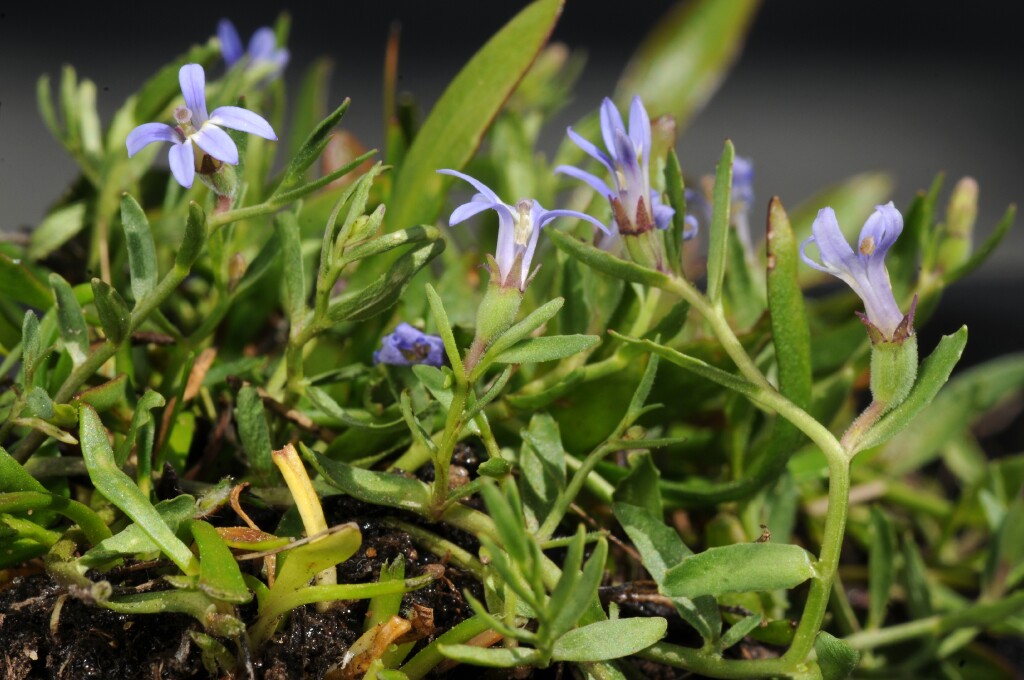Lobelia
Prostrate to erect annual or perennial herbs, producing milky sap. Leaves cauline, alternate, sometimes appearing distichous, entire to lobed. Flowers axillary and solitary, or in racemes or cymes, bisexual and protandrous, or unisexual (females often smaller); bracteoles inconspicuous or absent. Hypanthium c. oblique, sometimes gibbous; corolla slightly to strongly zygomorphic, 2-lipped or sometimes fan-shaped, lobes subequal or the upper 2 markedly dissimilar from lower 3, tube usually deeply slit to near base on upper side; staminal filaments adnate to or to shortly above base of corolla-tube, anthers connate in a tube, dorsal 3 anthers longer than ventral 2, ventral pair or all 5 anthers densely penicillate at tip, the ventral anthers sometimes with a longer apical seta; ovary 2-locular; stigma 2(rarely 3)-lobed, the lobes hemispherical to broadly oblong, surrounded by a brush of tiny hairs or with hairs in a band on the back of the lobes. Fruit a capsule or indehiscent and fleshy or dry; seeds numerous, terete, lenticular or angular, smooth, reticulate or ridged, rarely winged or pitted.
415 species, cosmopolitan, but especially in tropical and subtropical regions; 39 native and 2 naturalized species in Australia.
A variable genus likely to undergo considerable reclassification. Lammers (2011) placed indigenous Australian species in 2 sections: section Holopogon (this includes Victorian Lobelia browniana, Lobelia dentata, Lobelia gibbosa, Lobelia rhombifolia, and Lobelia simplicicaulis) for species with all anthers densely penicillate apically, and section Hypsela (remaining Victorian species) for species with the apex of lower 2 anthers each having a seta and shorter penicillate hairs. Victorian species previously placed in Pratia are now included in Lobelia within section Hypsela (Lammers 2011). Pratia was previously distinguished from Lobelia by having indehiscent fruit and intermediates between the two genera are known. However, fruit type was shown to be a poor choice of characters for delimitation at the genus level in Lobelioideae by phylogenetic analyses of DNA sequence data which revealed that the transition between indehiscent and dehiscent fruit is a frequently recurring event (Antonelli 2008). Phylogenetic analyses of DNA sequence data also supports placement of Australian Pratia species in section Hypsela (Heenan et al. 2008), providing further support for the inclusion of Pratia within Lobelia. Species currently placed in Isotoma also appear to belong to section Hypsela according to Phylogenetic analyses of DNA sequence data (Heenan et al. 2008), but no available names in Lobelia have been erected for Victorian species of Isotoma and consequently they are tentatively retained within Isotoma.
KEY TO GENUS
For key to this and related genera (Hypsela, Isotoma, Monopsis), see general key to the Campanulaceae.
Albrecht, D.E.; Walsh, N.G. (1999). Campanulaceae. In: Walsh, N.G.; Entwisle, T.J., Flora of Victoria Vol. 4, Cornaceae to Asteraceae, pp. 553–553. Inkata Press, Melbourne.
 Spinning
Spinning


